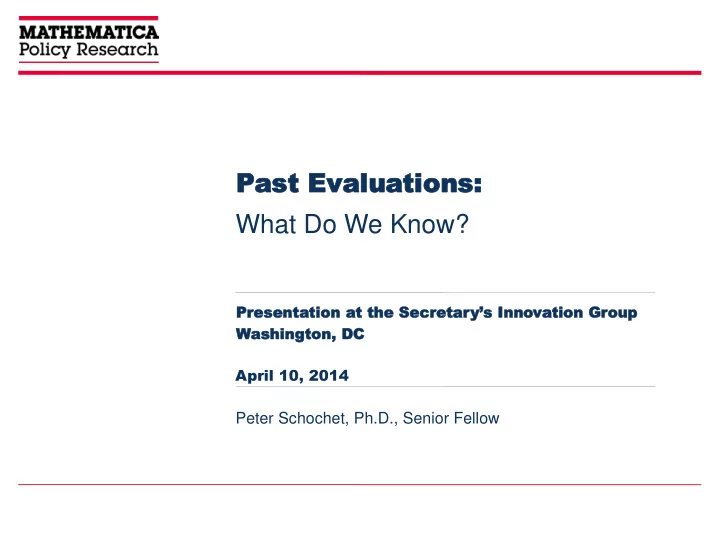

Pas ast t Ev Evalua aluations: tions: What Do We Know? Presentation at the Secretary’s Innovation Group Washing ington, , DC DC April 10, 2014 Peter Schochet, Ph.D., Senior Fellow
Rigorous Evaluations Are Feasible! • Many informative random assignment studies have been conducted – Range of interventions, including SNAP – Multiple settings – Diverse populations similar to SNAP recipients 2
What Employment Strategies Work? • Models that combine – Work experience – Skills training (especially in community colleges) – Intensive case management and support services – Activities that target specific industries • Providing only transitional jobs does not have long-term effects 3
How Can the Research Be Improved? • Unify the class of tested intervention across sites – Help interpret findings • Introduce planned variation – Go beyond the single treatment and control group – Vary promising intervention components • Evaluators should be selected early 4
For More Information • Peter Schochet pschochet@mathematica-mpr.com 5
Quasi-Experimental Designs for Social Policy Interventions Presentation at the Secretary’s Innovation Group Washington, DC Peter Z. Schochet Ph.D., Senior Fellow
Introduction and Summary There have been significant advances in the use of quasi-experimental methods to create credible comparison groups Experimental methods are still the best starting point for impact evaluations – Ensure unbiased estimates – Most precise estimates 2
Problems With Random Assignment Cannot always do RCTs – Entitlement programs – Undersubscribed programs – Site refusals Takes time to get results 3
What Are Alternative Designs? Pre-post or interrupted time series (ITS) Matched comparison group or propensity scoring Instrumental variable (IV) Regression discontinuity (RD) 4
Pre-Post or ITS Designs Ok if pre-period outcomes are very stable and there are large post-period effects Girl-Friendly %% Girls in School, by Year Schools Built 80 70 60 50 40 30 20 10 0 2000 2001 2002 2003 2004 2005 2006 2007 2008 2009 Year 5
Matched Comparison Group Designs Some studies found that these methods cannot replicate impacts from experiments – LaLonde (1986); Fraker and Maynard (1987); Agodini and Dynarski (2004); Peikes et al. (2008) Some studies are more optimistic – Heckman and Hotz (1989); Deheija and Wahba (1999); Mueser et al. (2007); Shadish et al. (2008) Some have expressed extreme caution – Smith and Todd (2005); Fortson et al. (2012) Literature on conditions with better replications – Glazerman et al. (2003); Heckman et al. (1997); Bloom et al. (2005); Cook and Wong (2008) 6
RD Designs Scoring rule is used to define who gets the treatment – Income threshold – Risk index Becoming increasingly popular Replication studies are promising (Cook & Wong 2008, Gleason et al. 2012) 7
Example: Early Reading First Evaluation Grants Were Awarded to Sites with the Highest Application Scores Cutoff Score 70 Print Awareness Score Funded 60 50 Unfunded Impact 40 30 20 10 0 40 45 50 55 60 65 70 75 80 85 90 95 Application Score 8
Conclusions Credible quasi-experimental designs are available if RCTs are not an option – But need the right conditions – Need larger samples than experimental designs 9
Samp Sample le Siz Size: e: How many study participants? Presentation at the Secretary’s Innovation Group Washing ington, , DC DC April 10, 2014 Peter Schochet, Ph.D., Senior Fellow
Having Sufficient Samples Is Critical • Estimates of program effects are measured with error • Need large samples to be able to say that likely program effects are different than zero • Requires sufficient enrollment to generate large treatment and control groups 2
What Determines Sample Size Needs? • Unit of random assignment – Smaller samples if individuals are randomized than “groups” • Expected effects – Smaller samples if impacts are likely to be large • Whether sites can be pooled • How much the outcomes vary across people 3
Example of Sample Size Requirements Mi Minimum nimum Pr Prog ogram Ef am Effec ects ts on on E Emplo mploymen yment (Per ercen centa tage ge Poin oints ts) Number of Sites Individuals SNAP Offices (100 treatments, 100 Randomized Randomized controls per site) (10 per site) 1 17 20 5 8 10 10 5 7 4
Recommend
More recommend